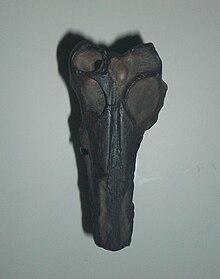Parapsicephalus
|
Parapsicephalus Temporal range: Toarcian, 182 Ma |
|
|---|---|
 |
|
| Fossil skull showing brain endocast (AMNH 1694) | |
| Scientific classification | |
| Kingdom: | Animalia |
| Phylum: | Chordata |
| Class: | Reptilia |
| Order: | †Pterosauria |
| Family: | †Rhamphorhynchidae |
| Genus: |
†Parapsicephalus Arthaber, 1919 |
| Type species | |
|
Parapsicephalus purdoni (Newton, 1888) |
|
| Synonyms | |
|
|
Parapsicephalus (meaning "beside arch head") is a genus of long-tailed rhamphorhynchid pterosaurs from the Lower Jurassic Whitby, Yorkshire, England. It contains a single species, P. purdoni, named initially as a species of the related rhamphorhynchid Scaphognathus in 1888 but moved to its own genus in 1919 on account of a unique combination of characteristics. In particular, the top surface of the skull of Parapsicephalus is convex, which is otherwise only seen in dimorphodontians. This has been the basis of its referral to the Dimorphodontia by some researchers, but it is generally agreed upon that Parapsicephalus probably represents a rhamphorhynchid. Within the Rhamphorhynchidae, Parapsicephalus has been synonymized with the roughly contemporary Dorygnathus; this, however, is not likely given a large number of differences between the two taxa, including the aforementioned convex top surface of the skull. Parapsicephalus has been tentatively referred to the Rhamphorhynchinae subgrouping of rhamphorhynchids, but it may represent a basal member of the group instead.
The type skull of Parapsicephalus, which is 14 centimetres (5.5 in) long as preserved, suggests that it was of medium size. Comparisons with the related pterosaurs Scaphognathus, Dorygnathus, and Jianchangnathus indicates that the full skull would have been 18–19.6 centimetres (7.1–7.7 in) long. Wellnhofer estimated its wingspan at 1 metre (3 ft 3 in); more recently, a referred humerus, which is 10 centimetres (3.9 in) long, has produced wingspan estimates of 1.68–3.26 metres (5 ft 6 in–10 ft 8 in).
When viewed from the side, the convex top of the skull formed a gentle slope. The elongate frontal process of the premaxilla, which extends backwards towards the eyes, may have supported a low crest along its midline. Below the nostril, the premaxilla meets with the maxilla; their junction is marked by a discontinuity in the surface texture of the bone. Overall, the oval-shaped antorbital fenestra, situated behind and separate from the nostril, measures 45 millimetres (1.8 in) long and 24 millimetres (0.94 in) tall. The maxilla extends backwards in a half-moon shape to encircle the front end of the fenestra, with the top prong of the maxilla forming a 45° angle with the horizontal. The top end of the fenestra is enclosed by the thin, rectangular, and slightly concave nasal, and the lacrimal, which is not well-preserved but may have been long, slender, and triangular. On the underside of the skull, the maxilla forms the majority of the palate (not the premaxilla, as previously assumed), extending back from below the external nostrils. Along the midline of the maxilla is situated a thin strip of bone, the vomer, which connects back to join the pterygoid.
...
Wikipedia
